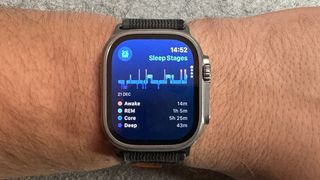In the midst of features such as Apple Intelligence, the big Siri/ChatGPT update, the iPad Calculator app and spacial photos on visionOS 2, watchOS 11 was a little bit lost in the noise of WWDC 2024.
The update to the operating systems for the best Apple Watches brought a number of exciting new features, such as an improved widget stack, live activities, new GPS workout profiles, AI-assistant photo collections for your watch face, improved women’s health tracking and a new Vitals app. Some good features, but it wasn’t as big a change as we saw last year, and it was jostling for space with showstoppers like the examples listed above. Consequently, watchOS 11 has been somewhat forgotten about by most pundits, who are focusing on Apple Intelligence and other AI features, and what they could mean for Apple going forward.
However, I think there’s a little bit more to watchOS 11 than meets the eye. This year, watchOS’s biggest changes are all about the Apple Watch’s capabilities to monitor more holistic health, rather than workouts and adventurous fitness-related pursuits. The Vitals app – designed to monitor sleep, skin temperature, and recovery – along with the Sleep app’s automatic sleep tracking functionality, are two such examples.
This is in line with all the best fitness trackers right now: last year’s Samsung Galaxy Watch 6 had a big sleep emphasis, and the best smart rings – tiny fitness trackers that passively, invisibly monitor heart rate, blood oxygen, stress and sleep quality – are all the rage right now. Fitness is out (or at least, as “out” as fitness can be) and wellness is in. It’s unsurprising Apple is following suit, but there’s a big barrier in the way of Apple rubbing shoulders with some of the other best sleep trackers on shelves right now: that damn battery life.

At the time of writing, Apple Watches are listed by Apple as lasting for 18 hours, less than a day. While, as a rule, this statistic tends to be very conservative, if you’re using some battery-draining features such as GPS workouts for runs, cycles, walks, or swims, you’re likely to get less than a day’s use out of a standard Apple Watch. The Apple Watch Ultra and Apple Watch Ultra 2 get more at 36 hours, but they’re much more expensive than the more basic models.
Despite the fact that Apple Watches charge very quickly, many people aren’t in the habit of wearing their watches overnight. They’ll end up charging them twice: once before bed, once in the morning – and, in my experience, the watch is usually left off the wrist at night, often on a wireless charger.
The emphasis on sleep features this year could mean that Apple is set to debut an Apple Watch 10 with better battery life, a highly requested feature from almost every Apple Watch user out there. I would love to see the inner workings of exactly how many people use Apple’s sleep tracking features – I’m willing to bet cash that it’s not that many – but I believe a revamp of the Watch’s sleep tracking capabilities signals intent to create a device that isn’t designed to be taken off for a long period of time.
It would be fantastic if Apple is able to incorporate the Apple Watch Ultra 2’s 36-hour battery life into the base Apple Watch 10. The standard Samsung Galaxy Watch 6’s battery life tops out at 40 hours, and I’d love it if Apple followed suit and made another, cheaper watch that could go the distance, lasting you through the night and into the following day.
You might also like…
Services Marketplace – Listings, Bookings & Reviews
